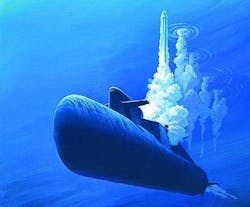APS to help develop deep undersea sonar technology to detect quiet hostile submarines
SAN DIEGO, 13 March 2013.Anti-submarine warfare (ASW) experts at Applied Physical Sciences Corp. (APS) in Groton, Conn., are designing technology for an extremely deep-operating undersea surveillance system to help protect U.S. Navy aircraft carriers and their support vessels from quiet enemy attack submarines.
APS won a $15.2 million U.S. Navy contract Monday to develop configurable technology to provide ASW surveillance over large deep ocean areas in which potentially hostile submarines might be hiding.
This is the second DSOP contract to APS, and involves the program's Phase 1b, Phase 2, and Phase 3 segments. Also working on the DSOP program are experts at Science Applications International Corp. (SAIC) in McLean, Va.
The contract is part of the Deep Sea Operations (DSOP) program of the U.S. Defense Advanced Research Projects Agency (DARPA) in Arlington, Va. Awarding the contract on behalf of DARPA are officials of the Space and Naval Warfare Systems Command in San Diego.
APS experts design a system architecture, define sensors and sensor processing, and define the large sensor system's communications mobility and energy requirements. The 15-month contract to APS includes a six-month option that could bring the potential value of this contract to $21.2 million.
APS will define a developmental sonar system for large-area coverage, significant fractional hold time, low operational cost, and other deep-sea ASW capabilities, with an emphasis on deep ocean platform mobility.
Navy fixed-site undersea sensor systems today include the Fixed Distributed System (FDS) and the Sound Surveillance System (SOSUS), which are used in ocean choke points in the Caribbean as well as the straits between Greenland, Iceland, Greenland, and the United Kingdom -- commonly referred to as the GIUK Gap.
The DSOP program seeks to use deep-sea areas known as the sound fixing and ranging channel -- also known as the deep sound channel -- that exists at ocean depths below about 3,000 feet where the water is cold, silent, and dense, and where the speed of sound is at its slowest.
Conditions in these areas act as a sound waveguide that enables low-frequency sound waves to travel for thousands of miles. DARPA wants APS to develop sensors that essentially look upward through this acoustically silent environment to detect the low-frequency sounds of enemy submarines against a quiet background at long ranges.
DARPA experts assume that deep-ocean areas are particularly advantageous for sound navigation and ranging technologies -- sonar for short -- yet will accept non-acoustic solutions, as well.
Goals of the program include the ability to achieve long-range detection and classification of submarines; the means to communicate underwater over long distances; and the ability to manage electrical energy to operate in hostile deep-ocean conditions for long periods.
Technologies that APS will develop could result in sensors that operate near the ocean bottom; take advantage of distributed nodes; that can be configured to a range of operations, and environments; and adapts to the mobility of friendly and enemy submarines and surface warships.
APS experts will do the work on this contract in Groton, Conn., and should be finished by June 2014.
For more information contact Applied Physical Sciences online at http://aphysci.com, SPAWAR at www.spawar.navy.mil, or DARPA at www.darpa.mil.

